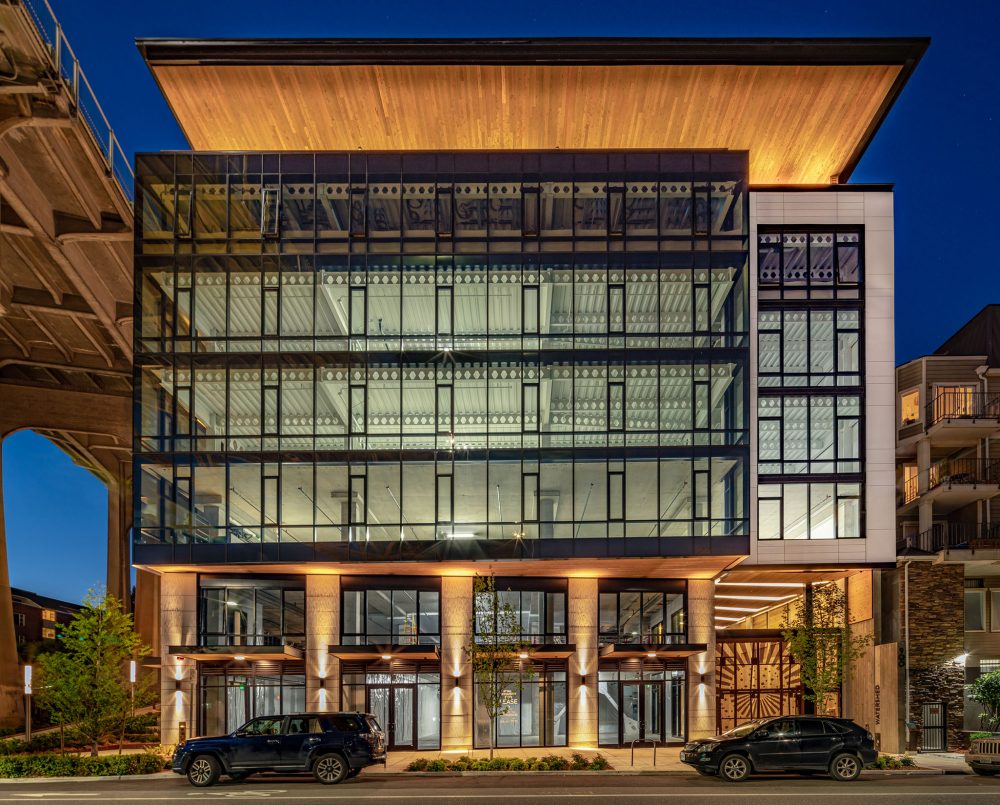By Kristen Scott
Kristen Scott is Managing Partner and Senior Principal of Weber Thompson where she heads the Workplace studio. As Managing Partner of Weber Thompson for more than 20 years, she has overseen the growth of the firm from its beginnings to the sustainably focused 70 person multi-disciplinary firm it is today.
The content for this article was originally featured in the Daily Journal of Commerce on June 3, 2021.
- Living Buildings sit at the intersection of health, beauty and performance.
Contrary to what you might think, in the midst of a global pandemic when the future of office space is unclear, it’s never been a better time to design and develop new offices as Living Buildings.
As the principal in charge of several Living Building projects in our firm, including Watershed, which was recently completed and now houses my firm’s offices, I have seen both how the financials work for the developer, and how the buildings are received by the user. It’s a win-win.
We’re all pondering how our work environments are going to change in response to the experiences of the past year. After all, for most office workers, the technology is there to work from home pretty seamlessly. What can commercial buildings offer that’s better than sweats and a couch with a laptop? These are some of the issues that employers are grappling with today, and they are answered by promoting a human-centered approach to design.

Living Buildings like Watershed look beyond their sites to improve their surrounding environment and contribute to a healthier community.
WORK-LIFE BALANCE
The past year of a lack of childcare, limited social activities, and more time needed for Zoom meetings versus in-person communication has resulted in emails and Slack messaging at all hours, lengthening the workday. There’s something to be said about divorcing work and home, having a physical office, a commute for transition and the ability to set work aside — if you want to — when you leave.
SOCIAL EQUITY
Working from home creates all sorts of challenges for informal mentorship, collaboration and equity. It’s hard to be on an equal playing field when everyone’s home circumstances are so varied. The comradery of an open office encourages conversational learning and collaboration in a way that formalized Zoom calls can’t replicate. As humans, so much of what we understand about another person is based on subtle cues, effortlessly gathered when we are in-person and searched for to exhaustion on a video call.
Why develop a high-performance office building? In a nutshell, it’s more profitable.
HIGHER RENTS
NAIOP shares national studies that green-certified buildings enjoy rents up to 2.3% higher than non-rated buildings; a MIT Real Estate study found that building owners received up to 37% higher rent for smart buildings than non-smart buildings. That’s quite a range, but it’s safe to say that deep green buildings are in demand and market demand results in faster lease-up times and higher rates.
MARKETPLACE DEMAND
Corporate mandates and employee interest about sustainable workplaces are now commonplace. Data from the publicly reported Energy Star Ratings to the environmental social and governance criteria commonly used by investment analysts in assessing property valuations are creating not only a groundswell of demand for high-performing assets, but a corresponding devaluation of underperforming so-called “brown” real estate. With Microsoft, Amazon and many other corporations committing to aggressive carbon neutrality goals, added pressure is increasing market awareness.
TENANT ATTRACTION
Increasingly, companies are being asked to demonstrate commitment to their values. As the population of millennials rapidly expands in the workforce they are prioritizing corporate sustainability practices as a key decision-making point for where they will work.
Living Buildings are certified based on actual performance, and their transparency and disclosure requirements put environmental accountability front and center. They require occupant participation and good, visible operational practices to support the significant energy and water reduction requirements leading to an engaged group of tenants.
In the detailed 2018 Stok Report, “The Financial Case for High Performance Buildings,” HPBs lead to an average increase of 6.9% net profit for the companies that lease them. Most interestingly, the bulk of this rise in net profits is based on increased productivity, improved health and wellness, and stronger employee retention, although building utility savings continue to contribute as well.
GOVERNMENT INCENTIVES
Seattle’s Green Building Standard (which requires Passive House, LEED Gold or ILFI’s Core Green Building Certification or equivalent) and the Living Building Pilot Program (LBPP) both incentivize deep green design through increased yields and faster permitting timelines. Regarding the Living Building Pilot Program, Joanna Callahan, one of the developers of the recently completed Watershed building states, “Do it! … the challenges are solvable. In the end, you only get to build once and LBPP is a win-win: it’s good for the planet and community, it’s attractive to tenants, and the 25% increase in FAR makes it pencil for developers.”
WHY LIVING BUILDINGS?
Living Buildings go beyond technical performance to connect community and nature. This broader focus embraces regenerative design, which heals our environment, providing resilience in the face of climate change, the existential crisis we collectively face.
MARKET TRANSFORMATION
Having worked on several Living Building Pilot projects, I often hear concern about the difficulty of vetting all of the building materials to meet the requirements of the Living Building Materials Petal. Happily it’s not the task that it used to be! Every new project contributes to the growing database of compliant products and educates manufacturers who are gaining familiarity with the disclosure requirements.
HEALTH AND WELLNESS
A visual connection to nature, along with well-designed access to natural daylight, has been shown to improve our health, increase our creative thinking and boost mental well-being. According to the latest Global ESG Benchmark for Real Assets report, unhealthy workers cost the economy $234 billion per year. Living Buildings combat this by embracing biophilic design principles, integrating natural patterns and access to nature into their core design. This is in stark contrast to the purely technical design approach of the last century which so often, under the guise of “protecting” occupants from their exterior environment, actually isolated them from it.
Living Buildings like Watershed look beyond their sites to improve their surrounding environment and contribute to a healthier community. Watershed’s terraced bioswales not only provide a beautiful public landscape to enjoy, they clean 400,000 gallons of toxic stormwater — coming off an overhead state highway — before reconnecting the water with Lake Union, a major salmon migratory route as well as a frequently used waterway for outdoor activities.
MOVING FORWARD
Pressure to change and adapt is coming from all directions. Now is the time to embrace the opportunity and create Living Buildings that improve our health, heal our communities and environment while demonstrating their value to landlords and tenants.
As poet Gary Snyder wrote, “Nature isn’t a place to visit. It is home.”
The human-centered design approach at the heart of Living Buildings reminds us of this imperative.
